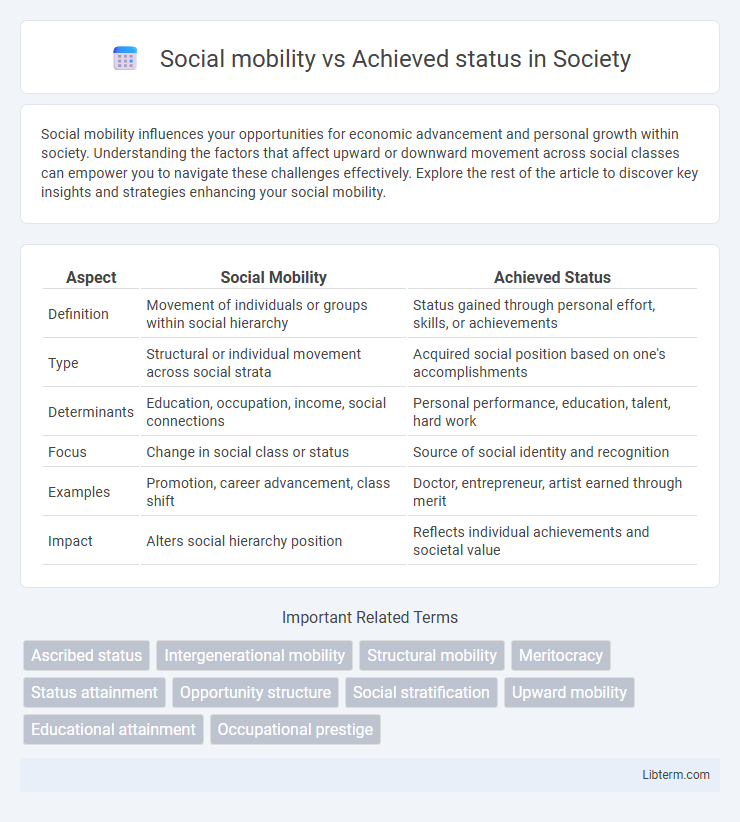Social mobility influences your opportunities for economic advancement and personal growth within society. Understanding the factors that affect upward or downward movement across social classes can empower you to navigate these challenges effectively. Explore the rest of the article to discover key insights and strategies enhancing your social mobility.
Table of Comparison
| Aspect | Social Mobility | Achieved Status |
|---|---|---|
| Definition | Movement of individuals or groups within social hierarchy | Status gained through personal effort, skills, or achievements |
| Type | Structural or individual movement across social strata | Acquired social position based on one's accomplishments |
| Determinants | Education, occupation, income, social connections | Personal performance, education, talent, hard work |
| Focus | Change in social class or status | Source of social identity and recognition |
| Examples | Promotion, career advancement, class shift | Doctor, entrepreneur, artist earned through merit |
| Impact | Alters social hierarchy position | Reflects individual achievements and societal value |
Defining Social Mobility
Social mobility refers to the movement of individuals or groups within a social hierarchy, which can be upward or downward based on changes in income, education, or occupation. Achieved status is the social position a person attains through personal effort, skills, and accomplishments rather than ascribed characteristics like race or family background. Understanding social mobility involves analyzing how achieved status enables individuals to improve their socioeconomic standing across generations or within their lifetime.
Understanding Achieved Status
Achieved status refers to a social position earned through individual effort, skills, or accomplishments, reflecting personal merit rather than inherited traits. This status is dynamic and often influences social mobility by enabling individuals to improve their social standing based on education, career success, or personal achievements. Unlike ascribed status, achieved status highlights the role of agency in shaping one's social identity and opportunities.
Types of Social Mobility
Social mobility encompasses various types, including horizontal mobility, which involves changes within the same social stratum, and vertical mobility, which refers to movement between different social levels, either upward or downward. Intergenerational mobility measures changes in social status between successive generations, while intragenerational mobility tracks shifts within an individual's lifetime. Achieved status is closely linked to upward vertical mobility, as it reflects personal accomplishments and efforts that alter an individual's social position.
Mechanisms Influencing Achieved Status
Mechanisms influencing achieved status include individual effort, educational attainment, and occupational skills, which directly impact social mobility by enabling movement within social hierarchies. Access to quality education and professional networks enhances opportunities for upward mobility by improving the likelihood of achieving higher occupational statuses. Socioeconomic factors such as family background, cultural capital, and social connections also play critical roles in facilitating or constraining the attainment of achieved status.
Social Mobility vs Achieved Status: Key Differences
Social mobility refers to the movement of individuals or groups within a social hierarchy, often measured by changes in income, education, or occupation, while achieved status is the social position a person attains through personal effort, skills, and accomplishments. The key difference lies in social mobility describing the process of change or movement between statuses, whereas achieved status signifies the outcome of that process based on individual achievements. Social mobility encompasses upward or downward shifts influenced by social structures, whereas achieved status emphasizes personal agency and merit in determining one's social standing.
How Education Impacts Both Concepts
Education serves as a critical driver of social mobility by providing individuals with skills and qualifications that increase access to higher socioeconomic positions. Achieved status, which reflects personal accomplishments, is heavily influenced by educational attainment, as it enables individuals to secure desirable jobs and social recognition. Higher levels of education correlate strongly with improved social mobility opportunities and enhancement of achieved status, demonstrating the transformative power of academic success in shaping social trajectories.
Cultural and Societal Influences
Social mobility is significantly shaped by cultural and societal influences that determine access to education, resources, and social networks, facilitating changes in an individual's social class. Achieved status depends on personal accomplishments such as career success or educational attainment, which are often influenced by cultural values emphasizing meritocracy and societal structures that either enable or restrict opportunity. Cultural norms and societal institutions play critical roles in either promoting upward mobility or reinforcing existing social hierarchies, affecting both social mobility and the realization of achieved status.
Barriers to Social Mobility and Achieved Status
Barriers to social mobility include systemic inequalities such as inadequate access to quality education, economic disparities, and discriminatory practices that limit opportunities for upward movement within society. Achieved status depends heavily on an individual's efforts and accomplishments, but obstacles like social capital deficits, limited resources, and entrenched social norms can restrict the ability to attain such status. Overcoming these barriers requires addressing structural issues that disproportionately affect marginalized groups and providing equitable opportunities for personal development and success.
Measuring Success: Mobility and Achievement
Measuring success in social mobility involves analyzing changes in an individual's socioeconomic position relative to their family background, emphasizing upward or downward movement across social strata. Achieved status reflects personal accomplishments such as education, occupation, and income, serving as key indicators of individual success. Studies use metrics like occupational prestige scales and income brackets to assess the extent to which achieved status influences social mobility outcomes.
Policy Implications and Future Directions
Social mobility, reflecting the capacity for individuals to change socioeconomic status across generations, requires policies that address systemic barriers like education inequality and labor market discrimination. Achieved status, determined by personal accomplishments such as education and career success, demands investment in skill development programs and equitable access to opportunities. Future policy directions emphasize integrating social support systems with targeted interventions to enhance upward mobility and reduce entrenched disparities.
Social mobility Infographic

 libterm.com
libterm.com